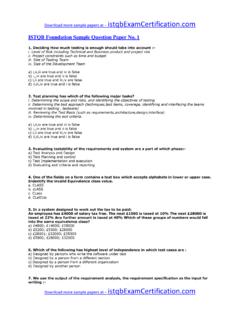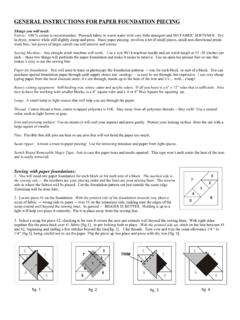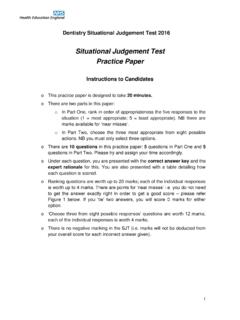Transcription of THE FEDERAL REDUCED STOPPING DISTANCE …
1 T H E F E D E R A L R E D U C E D S TO P P I N G D I S TA N C E. M A N DAT E : I M PAC T A N D S O L U T I O N S. U P DAT E D A U G U S T 2 0 1 3. Bendix Spicer Foundation Brake LLC. 901 Cleveland Street Elyria, Ohio 44035. 1-866-610-9709 T H E F E D E R A L R E D U C E D S T O P P I N G D I S TA N C E M A N D AT E : I M PA C T & S O L U T I O N S. TABLE OF CONTENTS. 1 : Important Terms .. 3-4. 2 : Executive Summary .. 5-6. 3 : Industry Trends in Braking .. 7-10. 4 : Understanding the New STOPPING DISTANCE Requirements .. 11-14. 5 : Braking Solutions .. 15-21. 6 : Meeting the REDUCED STOPPING DISTANCE Mandate .. 22-27. 7 : What the Mandate Means for the Industry.
2 28-31. 8 : Importance of Choosing OEM Replacement Parts .. 32-33. 9 : Conclusion ..34. 9 : About the Authors ..35. T H E F E D E R A L R E D U C E D S T O P P I N G D I S TA N C E M A N D AT E : I M PA C T & S O L U T I O N S 1:1 2. IMPORTANT TERMS. To aid your understanding of the content in this white paper, Bendix has compiled a list of key terms and definitions. Panic Stop Braking The new STOPPING DISTANCE regulation was developed to improve performance during panic stop braking, which is the ability of a vehicle to stop quickly under emergency conditions. Kinetic Energy Energy associated with motion. The greater a vehicle's kinetic energy, the greater the braking force needed to slow the vehicle.
3 Kinetic energy is defined by the equation KE = MV2, in which KE is kinetic energy, M is mass or load, and V is velocity or speed. Thermal Capacity The amount of heat the brake system can retain. Heat Dissipation Rate The rate at which the brake system converts kinetic energy into heat and releases it into the atmosphere. Torque Braking force. Brake Fade The condition in which the thermal capacity of the braking system has been exceeded and the system operates at REDUCED effectiveness. Hysteresis The lag in response between brake actuation and functioning. High-Performance Drum Brakes Foundation drum brakes engineered to develop the increased torque necessary for shorter stops, with features such as greater width, larger chambers, and additional lining.
4 T H E F E D E R A L R E D U C E D S T O P P I N G D I S TA N C E M A N D AT E : I M PA C T & S O L U T I O N S 1:2 3. Performance Metrics Key brake performance categories of torque, weight, and fade. Independent Wheel Control A characteristic of full electronic stability systems that enhances a vehicle's ability to meet the STOPPING DISTANCE requirement. Combination Lining Specially formulated friction material for maximum brake lining performance and longevity. T H E F E D E R A L R E D U C E D S T O P P I N G D I S TA N C E M A N D AT E : I M PA C T & S O L U T I O N S 1:3 4. EXECUTIVE SUMMARY. The United States and Canada have long emphasized their goal to more closely align the STOPPING - DISTANCE requirements for passenger cars and heavy trucks for increased highway safety.
5 They point to the difference in size between large trucks and passenger vehicles as a leading factor in the intensity of highway accidents. In its Dec. 15, 2005, notice of proposed rulemaking (NPRM) to improve the STOPPING DISTANCE performance After extensive studies and of truck tractors, the National Highway Traffic Safety industry outreach, NHTSA. decided on a 30 percent Administration (NHTSA) stated that while large trucks reduction, announcing its final operate on the same roadways as significantly lighter rule in July 2009. The agency passenger vehicles, they may take twice as long to determined that the transition to the new requirements stop in instances of panic stop braking.
6 In its proposal, would occur in two phases, NHTSA called for a 20 to 30 percent reduction in the with compliance dates of required STOPPING DISTANCE for large trucks. Aug. 1, 2011, and Aug. 1, 2013, depending on vehicle Bendix Spicer Foundation Brake LLC and Bendix type. Phase one comprises Commercial Vehicle Systems LLC together maintained the majority of commercial vehicles on the road today. a position that, for the sake of highway safety, NHTSA. should rule in favor of the maximum 30 percent reduction to shorten the STOPPING DISTANCE for large truck tractors. This 30 percent reduction, decreasing the maximum STOPPING DISTANCE for the vast majority of large commercial vehicles from 355 feet to 250 feet, would bring the trucks more in line with passenger cars.
7 The incremental benefit in terms of lives saved, accidents prevented, and property damage mitigated would be significantly greater than the cost of implementing a 30 percent reduction. After extensive studies and industry outreach, NHTSA decided on a 30 percent reduction, announcing its final rule in July 2009. The agency determined that the transition to the new requirements would occur in two phases, with compliance dates of Aug. 1, 2011, and Aug. 1, 2013, depending on vehicle type. Phase one comprises the majority of commercial vehicles on the road today. A variety of solutions are available to accommodate the level of reduction required in both phases.
8 The solutions are the result of intensive, ongoing brake system development, testing, and validation efforts that began years before the final rule was announced. T H E F E D E R A L R E D U C E D S T O P P I N G D I S TA N C E M A N D AT E : I M PA C T & S O L U T I O N S 2:1 5. In this paper, we will discuss the specifics of the FEDERAL REDUCED STOPPING DISTANCE mandate. The paper will outline how the ruling fits within the broader context of industry braking trends, examine the evolution and details of the mandate, note solutions that meet the requirements, and explore the mandate's impact on the trucking industry. Specific topics consist of: Industry Trends in Braking Factors affecting the development of braking systems today include stronger vehicle regulation and enforcement such as Compliance, Safety, Accountability (CSA) and increased focus on proper truck maintenance.
9 Understanding the New STOPPING DISTANCE Requirements How the FEDERAL mandate evolved, its requirements, and anticipated benefits. Braking Solutions A primer on foundation brakes the forms they take, the physics behind them, and the vehicle factors that affect their capabilities as well as advances in braking technology. Meeting the REDUCED STOPPING DISTANCE Mandate A wide variety of configurations will meet the requirements, but one solution will be chosen most often. And, while not required, the solution of air disc brakes will best optimize vehicle safety. What the Mandate Means for the Industry The impact of the new rule on OEMs and the vehicles they produce, fleets and owner- operators, and the aftermarket.
10 Also, the value proposition of higher-performing brakes. Importance of Choosing OEM Replacement Parts For the safest trucks that are always up to OEM standards, choosing only original equipment replacement parts is essential. Spec'ing the proper replacement brake linings is especially critical. T H E F E D E R A L R E D U C E D S T O P P I N G D I S TA N C E M A N D AT E : I M PA C T & S O L U T I O N S 2:2 6. INDUSTRY TRENDS IN BRAKING. The FEDERAL mandate for REDUCED STOPPING DISTANCE is best understood within the broader context of industry braking trends. Stronger Regulation and Enforcement The REDUCED STOPPING DISTANCE legislation is among a number of recent laws and regulations having an impact on braking systems and the commercial vehicle industry as a whole.











